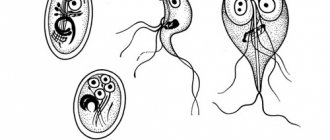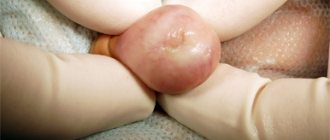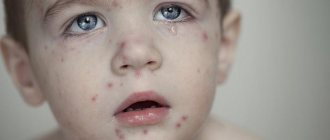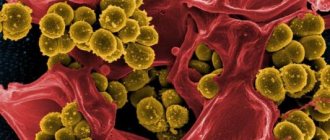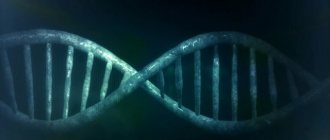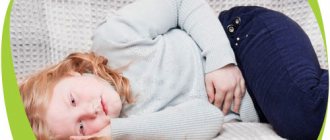Acetone syndrome is a condition characterized by an increase in ketone bodies in the blood due to metabolic disorders in the child’s body, primarily carbohydrate and fat metabolism. Ketone bodies are a group of specific substances that are normally synthesized in small quantities in the liver and are a kind of “spare fuel” for the body. However, in the presence of metabolic disorders, during carbohydrate starvation, the production of ketone bodies increases, which leads to their accumulation in the blood, as well as to massive release of ketones in the urine.
This pathology is not an independent disease, but is a symptom complex that can accompany or be one of the manifestations of the underlying disease or exist independently, without the presence of a background disease.
This syndrome can be detected in children of any age category, but is more often registered before the age of 12–13, more often in girls. However, it is worth saying that in the presence of an underlying disease, acetonemic syndrome can be detected at any age, and there is no correlation with the gender of the child. Recently, the relevance of this topic in pediatric practice is increasing every year, as the frequency of cases of detection of this pathology increases.
Causes of acetone syndrome
The immediate cause of the development of this disease is an increase in the level of ketone bodies in the blood. Considering the classification of this condition, it is worth considering separately the reasons for the development of each type of pathology.
At the present stage, the main reason for the development of primary acetone syndrome is considered to be the presence in a child of a so-called neuro-arthritic constitutional anomaly (which was previously called “neuro-arthritic diathesis” in the medical literature). This condition is a genetically determined anomaly of purine metabolism, which, in combination with the failure of lipid and carbohydrate metabolism, creates a tendency to increased formation of ketone bodies and the development of periodic acetonemic crises in the child. In addition, children with this constitutional anomaly have greater lability of the nervous system, which affects its response to various environmental factors.
The cause of the development of secondary acetone syndrome is a variety of pathological conditions:
- endocrinological diseases (diabetes mellitus, thyrotoxicosis, etc.);
- pathologies of the gastrointestinal tract (GIT);
- starvation;
- liver diseases;
- severe course of infectious diseases;
- tumor diseases;
- various types of injuries, surgical interventions.
Provoking factors also include stress, heavy physical activity, nutritional disturbances (lack of carbohydrates, predominance of protein and fatty foods, resulting in increased breakdown of fats, which after a cycle of complex biochemical processes are converted into ketone bodies).
All of these reasons lead to an increase in ketones in the child’s blood, which have a toxic effect on the body, especially on the central nervous system and gastrointestinal tract.
What to do during interictal periods?
Usually, all measures taken by doctors and parents are aimed at reducing the number of attacks and preventing exacerbations of the disease. Usually the doctor recommends at least two preventive courses of treatment per year, preferably in the off-season - in autumn and spring.
To help a baby with such a disease, you need to almost completely reconsider the child’s lifestyle. The basis of prevention is, no matter how trivial it may sound, a healthy lifestyle. This includes, of course, regular and fairly long stays in the fresh air, and it is better to combine it with outdoor games and sports. Regular and dosed physical activity leads to normalization of carbohydrate and fat metabolism, but it is important not to overdo it, as overwork can provoke attacks. Be sure to include water procedures in your daily routine - baths, contrast showers, dousing your limbs or the whole body. These procedures train the body, strengthen the baby and normalize metabolism. A baby needs at least 8-10 hours of sleep every day, and preschoolers need a mandatory nap during the day. You should avoid prolonged exposure to the sun and be sure to sharply reduce watching TV and working with the computer.
Protect your child from infectious diseases - such children are recommended to receive all preventive vaccinations according to the vaccination calendar, and if they go to kindergarten, additional ones.
Chronic diseases of the digestive system and other systems can impair the digestion and absorption of nutrients. As a result, there is an increase in the use of fat reserves, and this leads to the accumulation of ketone bodies in the blood.
In your diet, limit foods rich in fats and ketone-containing foods. However, doctors say that you shouldn’t completely remove fats from the diet; they are needed for the baby’s growing body - they are used to build cell membranes. Difficult-to-digest fats such as pork, lamb, as well as dishes such as cakes and cream pies, duck, rich broths should be completely excluded. But do not remove fats from the diet completely, they must be limited, and two-thirds replaced with vegetable oils - sunflower, olive, mustard. The ratio of proteins, fats and carbohydrates should be in the ratio: 1: 1: 4. It is worth sharply limiting the meat of young animals and poultry, fatty meats, smoked products, offal, sorrel, rhubarb, cauliflower, tomatoes, oranges and bananas in the diet , drinks containing caffeine and soda.
Preference in nutrition should be given to a vegetable-dairy diet; lactic acid products, cereals, fresh vegetables and fruits are almost always needed. Cottage cheese, lean fish, oatmeal, vegetable oil, which can facilitate the absorption of animal fats, are good for normalizing metabolism, and in moderate quantities it can be given to the child in combination with vegetables - in salads and vinaigrettes.
For children with acetonemic syndrome, there is a rule in preparing a diet - “fats burn in the flame of carbohydrates.” This would mean that fats can only be given in combination with carbohydrates. Put butter in porridge or vegetable stew, fried cutlets can only be with vegetable or cereal side dishes, sour cream in vegetable soup, vegetable or cereal casserole. When developing a diet, you need to take into account the individual tastes and characteristics of the baby; parents quickly notice which foods make the baby feel worse, and exclude them or strictly limit them. The first time may be a little difficult, but over time both you and the baby will get used to the new style of eating.
Advertising
Symptoms of acetone syndrome
Acetone syndrome begins acutely, but some children may experience weakness, headache, and nausea before developing clinical symptoms. The main symptoms that are detected in children with acetone syndrome are the following:
- Repeated vomiting is one of the most characteristic signs of acetone syndrome, and the vomit may be mixed with bile. It becomes impossible to give water or food to the child, since every such attempt causes vomiting. Against this background, children quickly develop dehydration.
- Dry skin.
- Severe symptoms of intoxication, which manifest themselves:
- pale skin with blush on the cheeks;
- increased body temperature;
- lethargy, apathy;
- drowsiness.
- Manifestations from the central nervous system:
- excitement at the initial stages of development of the syndrome, which then gives way to weakness;
- drowsiness;
- convulsions in severe cases;
- the development of acetonemic coma may occur in the absence of adequate therapy.
- The appearance of a characteristic odor of acetone in the air exhaled by the child.
- Abdominal pain of a cramping nature.
- Abnormal stool (diarrhea or constipation).
It is worth noting that this syndrome, in addition to the fact that it itself is capable of causing severe dehydration in a child, can also accompany and be the first manifestation of a fairly large number of pathological conditions, including life-threatening ones. Therefore, if a child has the listed symptoms, it is extremely important to seek help from a doctor as soon as possible to determine the cause of this condition and conduct adequate treatment for acetone syndrome.
Prevalence
AS is a disease predominantly of childhood, manifested by stereotypical repeated episodes of vomiting, alternating with periods of complete well-being. More often occurs in children of the first years of life. The prevalence of AS is poorly understood. AS affects 2.3% of Austrians, 1.9% of residents of Scotland. In India, AS accounts for 0.51% of all pediatric ward admissions. According to Russian literature, primary AS occurs in 4–6% of children aged 1 to 13 years. AS is more often registered in girls. The average age of onset of AS is 5 years. 50% of patients with this pathology require hospitalization and intravenous fluid administration. The average annual cost of examination and treatment of one patient with this pathology in the USA is 17 thousand dollars.
Diagnosis of acetone syndrome
Diagnosis of this disease is based on anamnestic data, the results of a physical examination of the child by a doctor, as well as data from additional diagnostic methods (laboratory and instrumental).
When talking with parents and the child, the doctor clarifies whether the patient has previously had acetonemic crises and finds out what could have caused the development of this condition now. After this, the doctor conducts a thorough examination of the patient.
Of the laboratory methods for diagnosing this disease, the following must be used:
- General clinical tests . When performing a general blood test, an increase in leukocytes and an increase in the erythrocyte sedimentation rate (ESR) may be observed. A general urine test reveals ketones (ketonuria). Determination of ketones is also possible using special test strips, which, when lowered into urine, change their color for a while (if they contain ketones). The color of the test strip is then compared with the samples on the package and the level of ketonuria is determined.
- Biochemical blood test , which necessarily determines the level of blood glucose, electrolytes, total protein, urea, liver tests, etc.
- Coprogram.
- Analysis of feces for helminth eggs.
Of the instrumental methods, ultrasound of the abdominal organs and kidneys is mandatory. Other instrumental studies are carried out if indicated.
Considering that this syndrome can occur due to many diseases, to diagnose the underlying pathological process, they consult specialists (endocrinologist, gastroenterologist, etc.).
Prevention measures
Measures to prevent acetone syndrome in children:
- exclusion of psycho-emotional and physical stress;
- outdoor recreation;
- hardening and water procedures;
- balanced fortified diet;
- exclusion from the diet of fatty, smoked, canned foods, legumes;
- Spa treatment;
- for symptoms of increased acetone, take sweets;
- Monitor the level of acetone in urine using test strips.
Treatment methods for acetone syndrome
Treatment of this disease consists not only in eliminating the main clinical manifestations of this pathological condition, but also in prescribing maintenance therapy, as well as a special diet after stopping the acetonemic crisis to prevent relapses.
A child with this disease is prescribed bed rest, fractional drinking (frequently drinking small portions of liquid), as well as a special diet based on easily digestible carbohydrate foods. Diet is a very important part of the treatment of this condition, therefore, in order to achieve a positive effect from therapy, it is necessary to adhere to all the doctor’s recommendations regarding the child’s diet. Drug treatment of an acetonemic crisis consists of prescribing antiemetic drugs and using special mixtures with electrolytes for soldering. If necessary, infusion therapy (intravenous drip administration of solutions) is carried out, which is also aimed at restoring lost fluid. In addition, sorbents, antispasmodics, and enzymes are prescribed. If there is an underlying disease, it must be treated. Also, the complex of therapeutic measures for acetonemic syndrome includes cleansing the intestines with an enema.
Diet with acetone in children
Nutrition during this period must be selected very individually, based on the fact that the child’s appetite is reduced and it is necessary to offer something that he will actually “eat with appetite.” Prepare your favorite healthy food. Do not force your child to eat. Feed in small portions, give pureed food at a comfortable temperature. Food should be easily digestible, rich in carbohydrates and low in animal fats.
To manage a child in an acute period, there is a European nutrition system “BRAT”:
- Bananas - banana
- Rise - rice
- Applesauce – baked apple puree
- Toast – dried bread
Additional variations available:
- “BRATT” (plus Tea)
- "BRATTY" (plus Yogurt - yogurt)
There are significantly more products that can be given to a child, the main thing is to offer them “carefully”, as the condition improves, making the menu more varied. The bulk of the diet should be foods containing carbohydrates (this is about 60-65% of the child’s energy needs).
A child with acetone syndrome is allowed to:
- Cereals and flour products, such as buckwheat, oatmeal, corn porridge, rice.
- Various sweets: crackers, biscuits, jelly, marmalade, marshmallows.
- Dairy products: yogurt, kefir, white cheese.
- Various vegetables and dishes made from them. During the period of exacerbation, it is better to use heat treatment.
- Berries and fruits.
- Meat products and dishes made from them: lean meats (rabbit, turkey, meat of adult animals - lean pork, beef); egg (1 per day) – boiled or in the form of an omelet.
- Fish and seafood: sea fish, green and brown algae.
What not to eat with acetonomia
To prevent a deterioration in the general condition and not provoke a re-increase in acetone levels, the following should be excluded from the diet:
- Fatty broths made from bones or meat (including poultry or fish)
- Fatty meats
- By-products (liver, kidneys, etc.)
- Smoking
- Crayfish and some types of fish
- Fat cottage cheese and sour cream
- Some types of vegetables
To receive detailed advice on nutrition and create a balanced diet for a child with acetonemia, sign up for a consultation with our experienced pediatricians.
Need some advice?
Sign up
Callback form
Application has been sent, we will contact you soon


